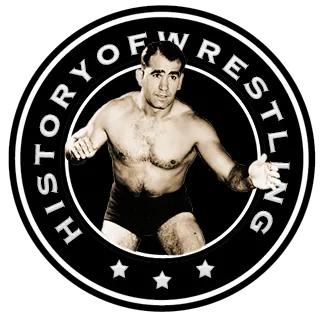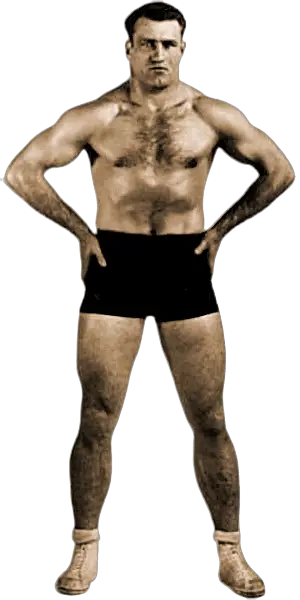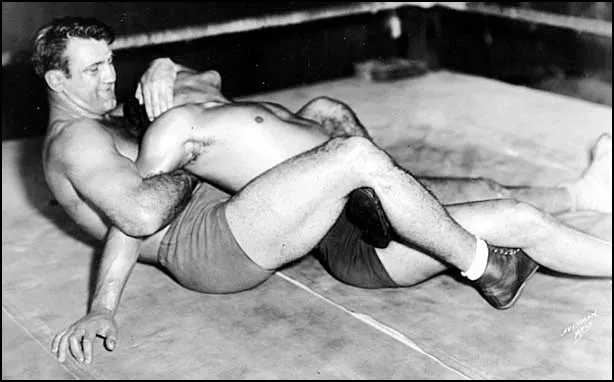by Stephen Von Slagle
In the early days of organized professional wrestling, charisma and marketability were already surpassing wrestling skill as the primary assets a wrestler could possess. During the Twenties, Thirties and Forties, the sport certainly featured a much more realistic look & feel, entirely because pro wrestling was supposed to be a legitimate sport, even though it no longer was. The bottom line of professional wrestling has always been just that; the bottom line. As the stakes were raised and the popularity of wrestling grew, it became clear to promoters that, while grappling prowess & ability was absolutely a requirement for success, pure ring skill was no longer the be-all, end-all of the mat game. At least not when it came to drawing paying fans to the show, which was/is the sole purpose of presenting a wrestling card. While it may be accurate to say that there were other wrestlers more talented inside of the ring than NFL superstar-turned-pro wrestler, the legendary Bronko Nagurski, few, if any, carried the same kind of name recognition and mainstream popularity that the famous former Chicago Bear enjoyed. However, as previously noted, pro wrestling greatness is determined by a performer’s ability to draw money, and exceptional in-ring ability is not always a sure-fire ticket to success. That said, Nagurski, a natural athlete in the truest sense of the term, never had any amateur experience as a wrestler but became a more-than-competent worker after his career as a football player ended. The combination of his acquired wrestling fundamentals, which eventually became quite solid, and brute strength (not to mention his famous name) eventually resulted in not one, but several reigns as the World Heavyweight champion for Nagurski. During the Thirties and Forties, Bronko was unquestionably one the biggest names in wrestling and he was among the most famous athletes (of any sport) in the country.
 Bronislau “Bronko” Nagurski was born on November 3, 1908 in Canada, but while still a toddler, his family moved to Minnesota and he spent the rest of his youth growing up in the States. From the start, Nagurski excelled at sports, and in particular, football. After graduating from high school, he attended the University of Minnesota and continued his amateur career in football, with great success. Nagurski, an All-American at the University of Minnesota from 1927 through 1929, quickly established himself as the best defensive player in the Big Ten, and perhaps the country. A testament to his unique talents, Nagurski was the only athlete in American collegiate history to become an All-Star at two different positions, Tackle and Full-back. Understandably, it didn’t take long for the National Football League to gain an interest in Nagurski and in 1930, his lifelong dream came true when he was approached by the legendary George Halas with a contract that enabled him to become a professional football player. Not only that, Nagurski was signed to one of the most respected and successful teams in N.F.L. history, the Chicago Bears. Halas’ newest defensive mauler quickly proved his worth, and Nagurski was the focal point of one of the greatest defensive squads ever, helping to lead the mighty Chicago Bears to the World championship in 1932. The next season, Nagurski’s “Monsters of the Midway” continued where they had left off, repeating as the 1933 World champions. The team’s back-to-back World championships and its complete dominance of the opposition placed them in an elite class of history’s best N.F.L. squads, and the Chicago Bears of the early Thirties, led by their star defensive player Bronko Nagurski, will forever be remembered as one of the greatest in the rich history of the National Football League.
Bronislau “Bronko” Nagurski was born on November 3, 1908 in Canada, but while still a toddler, his family moved to Minnesota and he spent the rest of his youth growing up in the States. From the start, Nagurski excelled at sports, and in particular, football. After graduating from high school, he attended the University of Minnesota and continued his amateur career in football, with great success. Nagurski, an All-American at the University of Minnesota from 1927 through 1929, quickly established himself as the best defensive player in the Big Ten, and perhaps the country. A testament to his unique talents, Nagurski was the only athlete in American collegiate history to become an All-Star at two different positions, Tackle and Full-back. Understandably, it didn’t take long for the National Football League to gain an interest in Nagurski and in 1930, his lifelong dream came true when he was approached by the legendary George Halas with a contract that enabled him to become a professional football player. Not only that, Nagurski was signed to one of the most respected and successful teams in N.F.L. history, the Chicago Bears. Halas’ newest defensive mauler quickly proved his worth, and Nagurski was the focal point of one of the greatest defensive squads ever, helping to lead the mighty Chicago Bears to the World championship in 1932. The next season, Nagurski’s “Monsters of the Midway” continued where they had left off, repeating as the 1933 World champions. The team’s back-to-back World championships and its complete dominance of the opposition placed them in an elite class of history’s best N.F.L. squads, and the Chicago Bears of the early Thirties, led by their star defensive player Bronko Nagurski, will forever be remembered as one of the greatest in the rich history of the National Football League.
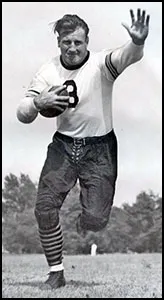 Despite the success and fame he gained as a Chicago Bear, the fact of the matter was pro football players were not highly paid at that time and, on the heels of winning his second World Championship with the Bears, Nagurski made headlines with his professional wrestling debut in 1933. He competed for several years as a two-sport star, but with his N.F.L. career winding down, and seeing the type of income he could earn as a wrestler, Nagurski eventually started wrestling more and more. Taking the advice of the reigning World champion at the time, Lou Thesz, Nagurski retired from football and began a full-time career as a professional wrestler. Under the tutelage of Minnesota promoter Tony Stecher, Bronko won his first major wrestling championship when he defeated Dean Detton and captured the Maryland version of the World Heavyweight title on June 16, 1937. Although the Maryland version of the World championship was one of several World titles being defended at the time, it was also one of the more prestigious titles of the day, and the well-known Nagurski not only benefited from his first championship, but the title itself gained credibility by having Bronko carry it. However, when he refused to grant a title shot to former champion Jim Londos, Nagurski was stripped of the title and the championship was vacated.
Despite the success and fame he gained as a Chicago Bear, the fact of the matter was pro football players were not highly paid at that time and, on the heels of winning his second World Championship with the Bears, Nagurski made headlines with his professional wrestling debut in 1933. He competed for several years as a two-sport star, but with his N.F.L. career winding down, and seeing the type of income he could earn as a wrestler, Nagurski eventually started wrestling more and more. Taking the advice of the reigning World champion at the time, Lou Thesz, Nagurski retired from football and began a full-time career as a professional wrestler. Under the tutelage of Minnesota promoter Tony Stecher, Bronko won his first major wrestling championship when he defeated Dean Detton and captured the Maryland version of the World Heavyweight title on June 16, 1937. Although the Maryland version of the World championship was one of several World titles being defended at the time, it was also one of the more prestigious titles of the day, and the well-known Nagurski not only benefited from his first championship, but the title itself gained credibility by having Bronko carry it. However, when he refused to grant a title shot to former champion Jim Londos, Nagurski was stripped of the title and the championship was vacated.
Having established himself as one of the wrestling’s top box-office draws, Bronko bounced back by gaining an even more prestigious World championship, the National Wrestling Association World Heavyweight title, by defeating Thesz on June 23, 1939 in Houston, TX. Over the course of the following nine months, the famous NWA World champion (and the promoters who had Nagurski wrestling on their card) enjoyed a great deal of success as he traveled the country defending his version of the World title. And, while there were other claimants to the World Championship also defending their belts at the same time as Bronko, his stature among the public was nearly unrivaled and the man who The Ring (once the most popular wrestling/boxing magazine in the country) referred to as “the true World champion” was, indeed, respected by all.
The rugged Nagurski eventually lost his NWA World title to Ray Steele on March 7, 1940 in St. Louis, Missouri, and spent the next year enjoying the reduced schedule of a non-champion. However, almost one year to the day since his loss of the title, Nagurski regained the National Wrestling Association World championship from Steele in Minneapolis, and he again became the reigning World champion. However, several months later, Nagurski was upset by Sandor Szabo on June 5, 1941. Although no one could have known it at the time, the loss, which took place in St. Louis, Missouri, would mark the end of The Bronko’s run as the World Heavyweight champion. It did not, however, end his career and Nagurski continued on as one of the top box-office draws in the business. In October of 1946, Nagurski, by now a seasoned ring veteran, gained some measure of revenge when he captured the National Wrestling Alliance’s Pacific Coast championship by defeating Sandor Szabo, the same man who had taken Bronko’s World title five years earlier. During their respective careers, Nagurski and Szabo met numerous times in the ring, with each man taking his share of victories (and championships) from the other. After dropping the Pacific Coast title to Billy Hansen several weeks after his win over Szabo, Bronko regained the once-prestigious title by defeating Len Hall on October 1, 1948 in Oakland, CA. However, just three weeks later, Szabo once again scored a win over his popular rival, and regained the Pacific Coast title as a result of his victory over Nagurski.
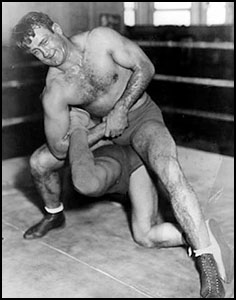 As the Forties became the Fifties, Nagurski entered his third separate decade in the wrestling business. Considering the punishment his body had taken during his career as a Chicago Bear and then as a World champion wrestler, it’s not surprising that the battered Nagurski began to slow a step or two. Still, in the world of professional wrestling, experience can often overcome youth, and Nagurski remained a top name (and champion) in the business. After years as a singles performer, Nagurski returned to “team sports” when he formed a highly successful duo with one of the brightest young stars in the business at the time, former N.C.A.A. champion Verne Gagne. Their team, which embodied youth & experience as well as science & power, became a big draw that was highly popular. This was even more the case after the duo won the World Tag Team title on December 26, 1957 by defeating the hated combo of Johnny Valentine & Chet Wallich. Nagurski and Gagne enjoyed a great deal of success during their lengthy reign as the tag champions before they finally lost their title belts to the brother combo of Doc and Mike Gallagher on March 22, 1958 in St, Paul, MN.
As the Forties became the Fifties, Nagurski entered his third separate decade in the wrestling business. Considering the punishment his body had taken during his career as a Chicago Bear and then as a World champion wrestler, it’s not surprising that the battered Nagurski began to slow a step or two. Still, in the world of professional wrestling, experience can often overcome youth, and Nagurski remained a top name (and champion) in the business. After years as a singles performer, Nagurski returned to “team sports” when he formed a highly successful duo with one of the brightest young stars in the business at the time, former N.C.A.A. champion Verne Gagne. Their team, which embodied youth & experience as well as science & power, became a big draw that was highly popular. This was even more the case after the duo won the World Tag Team title on December 26, 1957 by defeating the hated combo of Johnny Valentine & Chet Wallich. Nagurski and Gagne enjoyed a great deal of success during their lengthy reign as the tag champions before they finally lost their title belts to the brother combo of Doc and Mike Gallagher on March 22, 1958 in St, Paul, MN.
With decades’ worth of intense physical punishment finally beginning to take a toll of his body, the battered Nagurski made the decision to retire in 1960 following one of the most memorable athletic careers of modern times. After nearly three decades in the wrestling business, Nagurski hung his wrestling gear up and returned home to a quiet life in rural Minnesota.
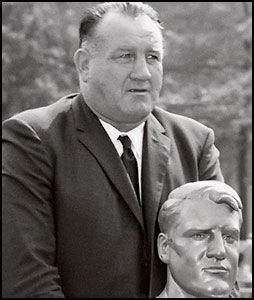 Considering his many accomplishments as a football player (both amateur and pro) it’s not surprising that Bronko Nagurski is a member of the N.F.L. Hall of Fame. Another tribute to his long-term impact is the annual Bronko Nagurski Award, an honor that is voted on by the Football Writers Association of America (F.W.A.A.) and given to the top amateur defensive football player in the country.
Considering his many accomplishments as a football player (both amateur and pro) it’s not surprising that Bronko Nagurski is a member of the N.F.L. Hall of Fame. Another tribute to his long-term impact is the annual Bronko Nagurski Award, an honor that is voted on by the Football Writers Association of America (F.W.A.A.) and given to the top amateur defensive football player in the country.
Bronko Nagurski is a member of the Wrestling Observer Newsletter Hall of Fame (1996), the International Wrestling Institute & Museum’s George Tragos/Lou Thesz Professional Wrestling Hall of Fame (2009) and the Professional Wrestling Hall of Fame and Museum (2011).
Bronislau “Bronko” Nagurski passed away on January 8, 1990 at the age of 82.
